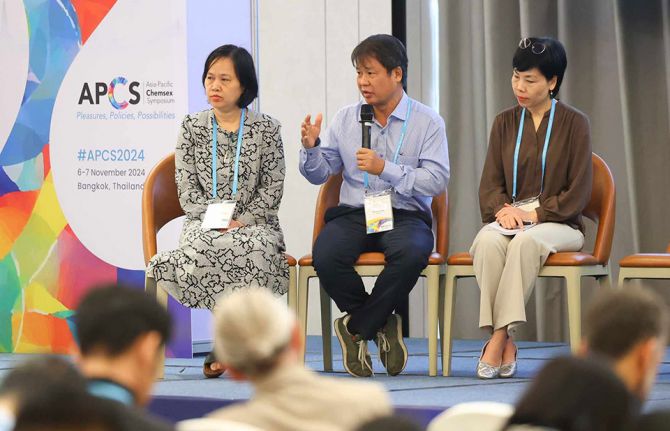
Feature Story
Spotlight: men who have sex with men and HIV
16 February 2009
16 February 2009 16 February 2009This article first appeared in the official programme of the 23rd Teddy Award

23rd TEDDY Award, 59th Berlinale International Film Festival
Film offers invaluable insights into the lives of different cultures, groups, and people. It is a medium that has a long history in addressing controversial topics and issues. For men who have sex with men, cinema has been a powerful platform to highlight the challenges they face in society.
From the 1969 release of Midnight Cowboy through to the works of Rosa von Praunheim, social acceptance of the acknowledgement and openness about men who have sex with men has grown. Most recently, major Hollywood films such as Brokeback Mountain (2006) have brought further mainstream attention and acceptance. Undoubtedly, AIDS – and its impact on this community – has been one of the most powerful storylines used in the past two decades, especially as the men who have sex with men community continues to be one of the groups hardest hit by the epidemic. The landmark film Philadelphia (1993) has been widely used to change attitudes towards AIDS and men who have sex with men, as well as to evoke an upsurge of compassion.
Nearly three decades since AIDS was first recognized, much progress has been made globally to prevent new HIV infections and provide antiretroviral therapy to those who need it. But men who have sex with men continue to bear a substantial burden of HIV infection, with increasing numbers of new infections occurring in a number of countries worldwide.
The Joint United Nations Programme on HIV/AIDS (UNAIDS) works closely with communities and organizations of men who have sex with men and promotes their leadership and participation in the global AIDS response. UNAIDS acts as a bridge builder, linking men who have sex with men and their organizations with governments, other civil society and international partners. UNAIDS’ role is to ensure commitment to the protection of the human rights of men who have sex with men, and support countries to put in place strategies and programmes to achieve universal access to HIV prevention, treatment, care and support.
Obstacles in responding to the sexual health needs of men who have sex with men
A significant hurdle in reaching out to men who have sex with men in a number of countries is the criminalization: few men who have sex with men come forward for fear of stigma, discrimination, and/or legal repercussions and this, in turn, impedes efforts to reach men who have sex with men, and their partners with HIV services, such as prevention, treatment, care and support. Within the diverse communities related to men who have sex with men are groups which are even more stigmatized, such as sex workers, men who are living with HIV, or transgender people, and their specific needs all require attention.
A recent report addressing HIV and men who have sex with men in a number of countries in Eastern Europe, the Caucasian Republics and Central Asia found that although most of the early cases of HIV in the region were diagnosed among men who have sex with men, this remains the least understood of the most-at-risk groups. Reasons include the reluctance of these men to be identified as such (even in a medical context), homosexual sex resulting in criminal prosecution in some countries, and, even the absence of criminal sanctions, stigmatization and physical violence.
In a survey conducted among men who have sex with men in Georgia in 2005, one quarter of those interviewed (25.7%) reported having faced social exclusion, discrimination and even violence by strangers, neighbours, family members and friends because of their sexual orientation. The survey revealed that 10% of all respondents had faced physical violence, with reports of beatings and two cases of rape, while other respondents reported social rejection and unfair dismissal from work.
The impact of violence against men who have sex with men has galvanized action in Latin America where Brazil and Mexico top the table of reported incidents. But this may be because rights groups there monitor the situation more closely than elsewhere in the continent.
UNAIDS encourages governments to “know their epidemic” and know how it affects men who have sex with men. Using this information, governments need to not only invest resources in supporting HIV prevention, treatment, care and support for men who have sex with men – tailored programmes that respond to their health needs – but also address the discrimination, violence and other barriers that stand in the way of accessing services.
Epidemic among men who have sex with men
Spanning a period of just 28 years since five gay men in the United States were the first identified with an unusual pattern of diseases later labeled AIDS, the epidemic has claimed the lives of more than 25 million people so far across the globe.
Sex between men occurs in every culture and society – though its extent and public acknowledgement vary from place to place – and is thought to account for between 5% and 10% of global HIV infections. It is the predominant mode of HIV transmission in many high-income countries and continues to be the population group most-at-risk of acquiring HIV within Western Europe. However, in countries reporting on access to HIV services by key population group, only around 40% of men who have sex with men have access to the HIV prevention and care services they need.
Regional trends
Sex between men is the most prominent mode of HIV transmission in nearly all Latin American countries, the United States, Canada and some Western European countries.
In both Canada and the United States, unprotected sex between men accounted for 40% of new HIV diagnoses in Canada in 2006 and 53% in the United States in 2005. The number of new HIV diagnoses attributed to unprotected sex between men has also increased sharply in recent years in Western Europe. In Germany, for example, the number of new HIV diagnoses among men who have sex with men rose by 96% between 2002 and 2006.
The urgency in Latin America is underlined by official reports on the state of the HIV epidemic in Colombia, Ecuador, Bolivia and Peru where sex between men is acknowledged as being the main source of new HIV infections.
In Asia, unprotected sex between men poses a significant but under-studied factor in the region’s HIV epidemics. In Bangkok, HIV prevalence among men who have sex with men went from 17% in 2003 to 28% in 2005. Male sex workers also face a particularly high risk of infection.
In Africa, several recent studies suggest that more attention is needed to better understand the role of HIV transmission among this population and that the proportion of the epidemic attributable to sex between men may be larger than hitherto thought, but there is still a great lack of information.
Looking ahead
Experience has shown that effective responses to HIV are those based on respect for human rights, and unimpeded access to HIV prevention, treatment, care and support. UNAIDS supports efforts to amend laws prohibiting sexual acts between consenting adults in private, enforce anti-discrimination legislation, provide legal aid services, and promote campaigns that address homophobia. These protections, alongside universal access to HIV prevention, treatment, care and support for men who have sex with men, will go a long way to turning the tide of the epidemic in many parts of the world.
Law, law enforcement practices, stigma and discrimination must be tackled as part of national AIDS responses as vulnerability to HIV infection is increased where men are either excluded from, or exclude themselves from, sexual health programmes and services out of fear. Gay, lesbian, bisexual and transgender communities must be – and have the right to be – empowered to participate equally in the social and political life of their communities and countries. These communities, who were the frontrunners in the early days of the AIDS response, are key partners today in the movement for universal access to HIV prevention, treatment, care and support.
Back to topRight Hand Content
Feature stories:
UNAIDS and TEDDY Award partner to raise awareness on HIV for 23rd edition (16 Feburary 2009)
Hidden HIV epidemic amongst MSM in Eastern Europe and Central Asia (26 January 2009)
China to tackle HIV indidence amongst MSM (16 January 2009)
HIV prevention hampered by homophobia (13 January 2009)
ICASA 2008: Men who have sex with men and HIV in Africa (07 December 2008)
MSM and the global HIV epidemic (31 July 2008)
Strengthening work with MSM in Africa (23 May 2008)
Global initiative to stop the spread of HIV among men who have sex with men (24 July 2007)
External links:
TEDDY Award
Berlinale
Berliner AIDS-Hilfe
Deutsche AIDS-Hilfe
Press centre:
UNAIDS and broad coalition working towards the release of nine men who have sex with men in Senegal who have been convicted and imprisoned (15 January 2009)
Criminalization of sexual behavior and transmission of HIV hampering AIDS responses (27 November 2008)
Publications:
Men who have sex with men, HIV prevention and care Report of a UNAIDS stakeholder consultation, Geneva, 10-11 November 2005 (pdf, 638 Kb)
Best Practice publication: HIV and men who have sex with men in Asia and the Pacific (pdf, 1.12 Mb)
Practical guidelines on HIV prevention
Men who have sex with men, HIV prevention and care (pdf, 638 Kb)


